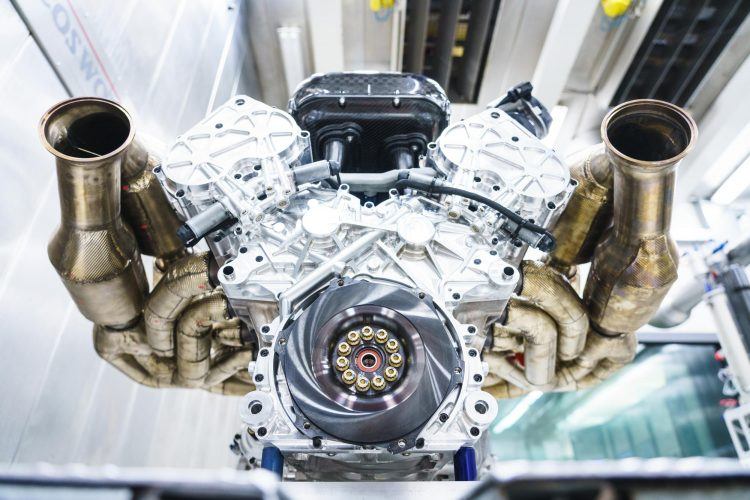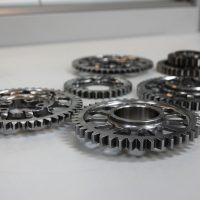- The new Aston Martin Valkyrie engine is a work of scientific art.
- The redline is through the roof and the horsepower ratings are off the charts.
- Developed in conjunction with Cosworth using proven F1 materials and methods.
Look, I don’t know what kind of drugs the engine department at Aston Martin is on, but I think they’re close to overdosing in the most positive way possible. Here we have the new V12 for the upcoming, Adrian Newey-designed Aston Martin Valkyrie hypercar, and it’s just mind-boggling.
The specs are stratospheric as is the redline.
And it sounds like Eddie Van Halen playing around with a chainsaw.
Fully-Stressed & Completely Insane
We still don’t know much about the chassis or aero specs for the Valkyrie, but you could probably put this plant in an AMC Pacer and wax a Porsche 911. Well, you’d have to stuff it into the “trunk,” since this Valkyrie V12 engine (mid-engine by the way) is a “fully stressed” member of the chassis. This has been standard racing practice since the first Cosworth DFV, but rarely has it been seen in a road-going car. The only one that springs to mind is the V12 Ferrari put into the F50.
Like the F50, the Valkyrie will have its V12 bolted directly to the carbon fiber tub. This makes perfect sense from a packaging and performance standpoint. From an everyday usability standpoint, it’s kinda iffy. All the vibrations, buzzes, shudders, and such are transmitted directly to the part of the car you’re sitting on and, therefore, right into your spine.
For a lot of people, this was seen as a huge flaw. For people like me (and I’m guessing people like Adrian Newey and the nut-jobs that made the F50) this is an added bonus. But I’ll keep any further discussions on this between me and my team of therapists.

The Aston Martin Valkyrie engine is “fully stressed,” meaning if removed, nothing connects the front wheels to the back. Aston Martin says keeping the engine’s weight down was a challenge. Photo: Aston Martin The Americas.
If Looks Could Kill
Anyway, that’s why this V12 looks rather strange. The cam covers, for example, have these odd buttresses and such, because that’s how the front of the engine bolts to the tub. The rear also has lots of odd features, but here we have an incomplete story. This is where the Valkyrie’s mill connects to the hybrid drive system/transaxle.
Yes, it’s a hybrid.
Yes, we can makes some jokes here about Toyota’s Prius.
Even though the engine is a fully-stressed chassis member, that means adding more weight to support the loads. The whole thing weighs just 206kg, or around 420 lbs. Kinda heavy, but not all that bad. It’s a narrow angle engine too, with a 65 degree angle between the banks. Since Newey is supremely aero-oriented, that leaves a designer with much more room under the car and around the engine so the ground effects tunnels can be that much larger.
The @astonmartin Valkyrie Engine sounds like Eddie Van Halen playing a chainsaw.
Click To Tweet
Power Figures: Off The Charts
Even though the thing is naturally-aspirated, the 6.5-liter V12 still cranks out a spectacular 1,000 bhp according to Aston Martin. That’s a very high and specific output: 153.8 bhp-per-liter. Also 6.5-liters is a pretty big displacement, which means its redline of 11,100 rpm is very notable. The pistons on a 6.5-liter plant are the size of your fist, so getting them moving in one direction, stopping them, then having them move in the opposite direction at high engine speeds is not easy.
Peak torque is just as inspiring with 546 lb-ft. being the mark you’re going to be concerned with. And keep in mind, these are the horsepower and torque specs for the engine by itself. The engine is just part of the entire powertrain. Added to that will be the power and torque (lots and lots of tasty, tasty torque) of the electric motors and quick-discharge batteries from the hybrid package.
Put another way, these horsepower and torque ratings are just the start for the Valkyrie.
I don't know what kind of drugs the engine department at @astonmartin is on, but I think they're close to overdosing in the most positive way possible.
Click To Tweet
Alexa? Find Me More Steel!
As I mentioned, this was not done all in-house at Gaydon. Cosworth had their say, adding in things like titanium conrods and F1-spec pistons hogged out from solid billet stock. The crankshaft is another fine example of Cosworth’s wizardry. It starts out as a big chunk of solid steel bar stock, then it’s roughed out, then heat treated, finish machined, heat treated again, gear ground, final ground, then superfinished.
Over the course of this process, 80 percent of the original bar stock is reduced to little metal shavings on the shop floor.
And like I said, this is just the engine part of the Valkyrie. Odin only knows what the rest of this beast will be like, but I bet it’ll be a killer.
“To anyone with a drop of petrol in their blood, a high-revving naturally aspirated V12 is the absolute pinnacle,” said Dr. Andy Palmer, Aston Martin Lagonda President and Group Chief Executive Officer. “Nothing sounds better or encapsulates the emotion and excitement of the internal combustion engine more completely.”
Tony Borroz has spent his entire life racing antique and sports cars. He is the author of Bricks & Bones: The Endearing Legacy and Nitty-Gritty Phenomenon of The Indy 500, available in paperback or Kindle format. Follow his work on Twitter: @TonyBorroz.
Aston Martin Valkyrie Engine Gallery












Photos & Source: Aston Martin The Americas.
from Automoblog.net https://ift.tt/2Ck3rfg


No comments:
Post a Comment